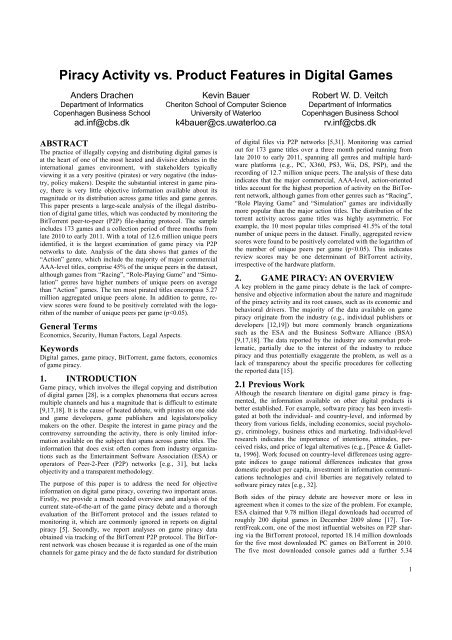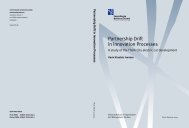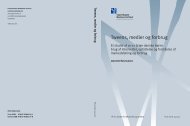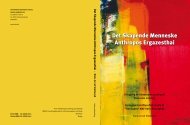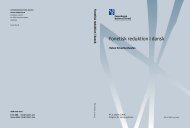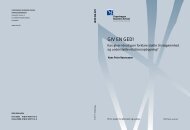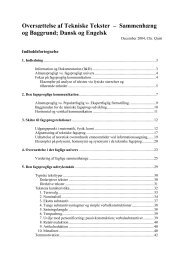Piracy Activity vs. Product Features in Digital Games - OpenArchive ...
Piracy Activity vs. Product Features in Digital Games - OpenArchive ...
Piracy Activity vs. Product Features in Digital Games - OpenArchive ...
You also want an ePaper? Increase the reach of your titles
YUMPU automatically turns print PDFs into web optimized ePapers that Google loves.
<strong>Piracy</strong> <strong>Activity</strong> <strong>vs</strong>. <strong>Product</strong> <strong>Features</strong> <strong>in</strong> <strong>Digital</strong> <strong>Games</strong><br />
Anders Drachen<br />
Department of Informatics<br />
Copenhagen Bus<strong>in</strong>ess School<br />
ad.<strong>in</strong>f@cbs.dk<br />
ABSTRACT<br />
The practice of illegally copy<strong>in</strong>g and distribut<strong>in</strong>g digital games is<br />
at the heart of one of the most heated and divisive debates <strong>in</strong> the<br />
<strong>in</strong>ternational games environment, with stakeholders typically<br />
view<strong>in</strong>g it as a very positive (pirates) or very negative (the <strong>in</strong>dustry,<br />
policy makers). Despite the substantial <strong>in</strong>terest <strong>in</strong> game piracy,<br />
there is very little objective <strong>in</strong>formation available about its<br />
magnitude or its distribution across game titles and game genres.<br />
This paper presents a large-scale analysis of the illegal distribution<br />
of digital game titles, which was conducted by monitor<strong>in</strong>g the<br />
BitTorrent peer-to-peer (P2P) file-shar<strong>in</strong>g protocol. The sample<br />
<strong>in</strong>cludes 173 games and a collection period of three months from<br />
late 2010 to early 2011. With a total of 12.6 million unique peers<br />
identified, it is the largest exam<strong>in</strong>ation of game piracy via P2P<br />
networks to date. Analysis of the data shows that games of the<br />
“Action” genre, which <strong>in</strong>clude the majority of major commercial<br />
AAA-level titles, comprise 45% of the unique peers <strong>in</strong> the dataset,<br />
although games from “Rac<strong>in</strong>g”, “Role-Play<strong>in</strong>g Game” and “Simulation”<br />
genres have higher numbers of unique peers on average<br />
than “Action” games. The ten most pirated titles encompass 5.27<br />
million aggregated unique peers alone. In addition to genre, review<br />
scores were found to be positively correlated with the logarithm<br />
of the number of unique peers per game (p
million downloads [31]. The lack of methodological scrut<strong>in</strong>y by<br />
objective third parties is also a problem for government-solicited<br />
research.<br />
The credibility of <strong>in</strong>dustry-based or government-solicited reports<br />
is also harmed by the common methodological problems <strong>in</strong> such<br />
work, which foster suspicion of bias [e.g., 14,15,30]. As noted by<br />
Anderson [2011]: “When a TV/movie company like NBC Universal<br />
funds a P2P study from a company that specializes <strong>in</strong> antipiracy<br />
work, the end result is hardly a dis<strong>in</strong>terested piece of data”<br />
[para. 4]. For example, Huygen et al. [15] exam<strong>in</strong>ed music, film<br />
and game piracy <strong>in</strong> the Netherlands, and via an onl<strong>in</strong>e survey of<br />
non-randomly selected Internet users <strong>in</strong> the Netherlands (n=778),<br />
extrapolat<strong>in</strong>g their f<strong>in</strong>d<strong>in</strong>gs to make conclusions about the entire<br />
Dutch population. Similarly, Envisional [13], a piracy research<br />
firm, concluded <strong>in</strong> a technical report commissioned by NBC<br />
Universal that among other th<strong>in</strong>gs music piracy is virtually gone<br />
from BitTorrent, with only 2.9% of the 10,000 “most popular<br />
torrents” exam<strong>in</strong>ed be<strong>in</strong>g music files (console games compris<strong>in</strong>g<br />
2.8% and PC games 3.9%). However, these conclusions are based<br />
on a somewhat flawed snapshot methodology, which is likely to<br />
overestimate the popularity of larger files, such as games, which<br />
take much longer to download and underestimate the popularity of<br />
smaller files, such as music, which take much less time to download.<br />
The potential impact of digital piracy on <strong>in</strong>dustry is notoriously<br />
hard to estimate reliably [14,15,30]. However, accord<strong>in</strong>g to the<br />
BSA [9] piracy of digital products is on the rise, with global software<br />
piracy <strong>in</strong> 2009 ris<strong>in</strong>g two percent, represent<strong>in</strong>g a total 51.5<br />
billion USD <strong>in</strong> lost revenue. A reliable figure for digital games is<br />
– to the best knowledge of the authors - unknown.<br />
2.2 Distribution Channels<br />
A key challenge for <strong>in</strong>vestigations of game piracy is that the<br />
channels through which illegal copies are distributed (e.g., physical<br />
copy<strong>in</strong>g, peer-to-peer networks) are almost impossible to<br />
monitor effectively [2,5,6,17].<br />
Distribution channels digital material <strong>in</strong>clude physical as well as<br />
networked solutions, with the most common onl<strong>in</strong>e be<strong>in</strong>g P2P<br />
protocols [17] and “one-click” file host<strong>in</strong>g services and the copy<strong>in</strong>g<br />
and distribution of digital material on physical media offl<strong>in</strong>e.<br />
Distribution channels such as Usenet, File Transfer Protocol<br />
[FTP] and Internet Relay Chat (IRC) were arguably important<br />
previously, but have become less frequently used s<strong>in</strong>ce the emergence<br />
of P2P protocols a bit over a decade ago [6], and are thus<br />
covered <strong>in</strong> less detail here.<br />
Develop<strong>in</strong>g reliable estimates of the piracy activity that occurs via<br />
any channel of distribution is challeng<strong>in</strong>g, however, the BitTorrent<br />
file exchange protocol is generally viewed as the major channel<br />
for game piracy today [17,18]. This conclusion is confirmed<br />
by reports highlight<strong>in</strong>g that P2P-based traffic comprises a sizeable<br />
fraction of the traffic on the Internet, with estimates vary<strong>in</strong>g from<br />
40-60% [e.g., 26].<br />
2.2.1 Usenet<br />
Usenet is a decentralized network launched <strong>in</strong> the 1980s to permit<br />
the shar<strong>in</strong>g of conversations before the development of web forums.<br />
Usenet forms a source of piracy via upload<strong>in</strong>g of files rather<br />
than messages to newsgroups. The files are retrieved us<strong>in</strong>g newsreader<br />
clients. While Usenet <strong>in</strong> the past may have played a role <strong>in</strong><br />
file distribution, it is likely not a factor <strong>in</strong> the contemporary game<br />
piracy.<br />
2.2.2 FTP<br />
The File Transfer Protocol is specifically designed for serv<strong>in</strong>g<br />
files over the Internet. FTP servers are centralized and therefore<br />
prone to be<strong>in</strong>g shut down by legal entities if discovered to host<br />
illegal content. FTP access is usually restricted to a small group<br />
and hence not a common piracy method for the general public.<br />
2.2.3 IRC<br />
The Internet Relay Chat method was developed <strong>in</strong> the late 1980s<br />
to facilitate real-time communication, before the development of<br />
<strong>in</strong>stant messag<strong>in</strong>g clients. IRC can be used to share files, but<br />
download<strong>in</strong>g files over IRC can be technically complicated compared<br />
to other methods, and may <strong>in</strong>volve long wait<strong>in</strong>g periods.<br />
2.2.4 Physical Distribution<br />
Pre-dat<strong>in</strong>g the <strong>in</strong>ternet, the illegal physical copy<strong>in</strong>g, distribution or<br />
sell<strong>in</strong>g of software, <strong>in</strong>clud<strong>in</strong>g digital games, is the oldest form of<br />
digital piracy and has existed for as long as digital content has<br />
been available on portable media. Physical piracy <strong>in</strong>volves the<br />
distribution – sell<strong>in</strong>g, giv<strong>in</strong>g or swapp<strong>in</strong>g –of unauthorized physically<br />
copied media, <strong>in</strong>clud<strong>in</strong>g game DVDs and CDs. The distribution<br />
networks employed vary from small circles of friends to<br />
organized crime where bus<strong>in</strong>esses revolve around the mass duplication<br />
of pirated media, and distribution/sale at competititive<br />
prices [17]. In some cases, illegally duplicated software is hard to<br />
dist<strong>in</strong>guish from the orig<strong>in</strong>al (legitimate) versions. The magnitude<br />
of this piracy channel is difficult to estimate with any degree of<br />
accuracy, but is common <strong>in</strong> certa<strong>in</strong> countries, such as Italy and<br />
Hong Kong, who are on the watch list of the International Intellectual<br />
Property Association [17].<br />
2.2.5 File-host<strong>in</strong>g Services<br />
File-host<strong>in</strong>g services (e.g., RapidShare.com, MegaUpload.com)<br />
consist of servers to where digital content can be uploaded to and<br />
downloaded from, provided that the user has access rights to do<br />
so. While the use of file host<strong>in</strong>g services can be legitimate, this<br />
type of service can also be used to host and share illegally copied<br />
digital material, as shown by Antoniades et al. [1] who exposed<br />
how “one-click” host<strong>in</strong>g services offer copyright-protected content.<br />
Users of file host<strong>in</strong>g services can access such material simply<br />
by search<strong>in</strong>g for content of <strong>in</strong>terest. The use of one-click host<strong>in</strong>g<br />
services can be appeal<strong>in</strong>g to people wish<strong>in</strong>g to distribute illegally<br />
copied content because they require only very limited technical<br />
knowledge to access. For example, standard HTTP web l<strong>in</strong>ks to<br />
specific files can be shared and search for us<strong>in</strong>g standard web<br />
browsers. Recently, Maier et al. [21] noted a shift <strong>in</strong> the distribution<br />
of Internet traffic, claim<strong>in</strong>g that the majority of Internet traffic<br />
by volume is a result of stream<strong>in</strong>g media websites (e.g., youtube.com)<br />
as well as file host<strong>in</strong>g services.<br />
2.2.6 P2P Protocols<br />
P2P protocols enable end-users to share content with one another<br />
directly, elim<strong>in</strong>at<strong>in</strong>g the need for upload<strong>in</strong>g digital content to a<br />
central server for mass distribution, as is the case with file-host<strong>in</strong>g<br />
services. Various P2P protocols have been developed over the<br />
past decade, <strong>in</strong>clud<strong>in</strong>g Gnutella, FastTrack and BitTorrent. Contrast<strong>in</strong>g<br />
with the server-client dissem<strong>in</strong>ation models, these protocols<br />
allow users to act as hosts of digital content as well as users<br />
of digital content. This means that the amount of bandwith available<br />
for other peers <strong>in</strong> the network scales with the number of peers<br />
(or users) who host the entire piece of digital content or just part<br />
of it.<br />
2.3 Legal Entities Monitor<strong>in</strong>g BitTorrent<br />
The BitTorrent protocol publicly shares <strong>in</strong>formation about the<br />
peers that access the network (or “swarm”) and engage <strong>in</strong> file<br />
2
shar<strong>in</strong>g. Thereby, the IP addresses of the participants [20] can be<br />
obta<strong>in</strong>ed by query<strong>in</strong>g the trackers used to provide <strong>in</strong>formation<br />
about specific torrents [23] or via crawl<strong>in</strong>g the BitTorrent Distributed<br />
Hash Tables (DHT) [30].<br />
In contrast to the relatively simple legal process <strong>in</strong>volved <strong>in</strong> remov<strong>in</strong>g<br />
content from “one-click” services, P2P protocols make<br />
the task respond<strong>in</strong>g to reports of piracy more difficult, as each<br />
<strong>in</strong>dividual peer who is participat<strong>in</strong>g <strong>in</strong> the shar<strong>in</strong>g must be identified<br />
and contacted. From a legal standpo<strong>in</strong>t, if copyright-protected<br />
content can be shown to have been uploaded to a service, the<br />
operators can be forced (through appropriate legal channels) to<br />
comply with requests to remove the material. Despite the challenge<br />
of f<strong>in</strong>d<strong>in</strong>g and contact<strong>in</strong>g peers host<strong>in</strong>g specific illegal<br />
digital content, entities act<strong>in</strong>g on behalf of copyright holders have<br />
attempted to monitor BitTorrent file transfers on a massive scale<br />
[23]. This has led to an arms race, where P2P network operators<br />
and copyright holders respectively attempt to circumvent the<br />
opponent’s methods for baffl<strong>in</strong>g and penetrat<strong>in</strong>g torrent networks<br />
[30]. However, Piatek et al. [23] showed how the techniques<br />
commonly employed are prone to a wide variety of errors, lead<strong>in</strong>g<br />
to highly <strong>in</strong>accurate estimates of piracy activity and, worse, <strong>in</strong><br />
some cases, falsely accus<strong>in</strong>g <strong>in</strong>nocent people of violat<strong>in</strong>g copyright<br />
laws.<br />
Irrespective of the attempts by copyright <strong>in</strong>vestigators to employ<br />
techniques such as the above to identify users engaged <strong>in</strong> copyright<br />
violation via P2P networks, the <strong>in</strong>herent public nature of the<br />
BitTorrent participants makes it an ideal measurement platform<br />
for obta<strong>in</strong><strong>in</strong>g concrete empirical data on game piracy. Notably,<br />
with the recent evolution of BitTorrent, which has seen the <strong>in</strong>corporation<br />
of additional mechanisms for peer identification (<strong>in</strong><br />
addition to the centralized tracker servers), such as DHTs, as well<br />
as a gossip-based mechanism called Peer Exchange (PEX) [see<br />
e.g. 7]. These features make it easier to identify peers.<br />
3. METHOD<br />
In order to obta<strong>in</strong> the data necessary for the analysis of game<br />
piracy, two data streams are necessary: 1) BitTorrent data on the<br />
onl<strong>in</strong>e distribution of illegal copies of digital games; 2) Information<br />
about the products. The steps towards obta<strong>in</strong><strong>in</strong>g these data are<br />
comprised of a series of steps, as follows:<br />
3.1 Obta<strong>in</strong><strong>in</strong>g Unique Peers from BitTorrent<br />
The BitTorrent protocol basically works by break<strong>in</strong>g down files<br />
that peers (users) seek to share <strong>in</strong>to many pieces of a specific size.<br />
Each of these is described via cryptographic hashes conta<strong>in</strong>ed <strong>in</strong> a<br />
metadata file, together with additional <strong>in</strong>formation such as a<br />
Uniform Resource Identifier (URI), and shared with a tracker<br />
server that lists all participat<strong>in</strong>g peers [5,6]. The metadata file is<br />
distributed to the users via the tracker server. BitTorrent search<br />
eng<strong>in</strong>es (e.g., thepiratebay.org and isohunt.com), host the metadata<br />
files and provide a search capability for peers. Upon hav<strong>in</strong>g<br />
obta<strong>in</strong>ed the metadata for a particular file (or “torrent”), peers can<br />
access the file via client-side BitTorrent software contact<strong>in</strong>g the<br />
track<strong>in</strong>g server to obta<strong>in</strong> a randomly selected subset of the users<br />
currently shar<strong>in</strong>g the file. Importantly, <strong>in</strong> the process of obta<strong>in</strong><strong>in</strong>g<br />
a peer list from the server, the peer implicitly registers itself with<br />
the tracker, enabl<strong>in</strong>g other peers to contact it and request parts of<br />
the file (when these are available, i.e. have been downloaded).<br />
For the current study, a list of 173 game titles was compiled<br />
across genres and hardware platforms <strong>in</strong>clud<strong>in</strong>g Xbox360, PlayStation<br />
3, N<strong>in</strong>tendo Wii, PC, N<strong>in</strong>tendo DS (DS) and PlayStation<br />
Portable (PSP). This list <strong>in</strong>cluded a series of games released <strong>in</strong> the<br />
fall 2010, and every game released s<strong>in</strong>ce November 17th 2010<br />
until 29th January 2011, the end of the track<strong>in</strong>g period (note that<br />
games can appear on BitTorrent prior to the official launch date).<br />
The sample consisted of games from all genres (irrespective of the<br />
specific def<strong>in</strong>ition system), rang<strong>in</strong>g from AAA-level major commercial<br />
titles (e.g., Bioshock 2, Need for Speed: Hot Pursuit,<br />
Civilization 5, Little Big Planet 2, Fallout: New Vegas) to casual<br />
and <strong>in</strong>die games (e.g., Auditorium, Super Meat Boy, Maj<strong>in</strong> and<br />
the Forsaken K<strong>in</strong>gdom). Of these 173 titles, with<strong>in</strong> the period of<br />
track<strong>in</strong>g (November 17th 2010 to February 6th 2011), 127 were<br />
located on BitTorrent, <strong>in</strong>dicat<strong>in</strong>g these games had been cracked of<br />
any copyright protection (DRM, <strong>Digital</strong> Rights Management), and<br />
released on BitTorrent. Dur<strong>in</strong>g the period of track<strong>in</strong>g, 12.6 million<br />
unique peers were identified for all these games, mak<strong>in</strong>g this the<br />
to date largest study of BitTorrent-based game piracy, surpass<strong>in</strong>g<br />
even the report of the Enterta<strong>in</strong>ment Software Association (ESA)<br />
from 2009, who reported 9.58 million downloads for about 200<br />
unspecified titles produced by members of the ESA dur<strong>in</strong>g one<br />
month <strong>in</strong> late 2009 (no detailed <strong>in</strong>formation has been revealed,<br />
<strong>in</strong>clud<strong>in</strong>g methodology and the specific titles <strong>in</strong>volved). Forty of<br />
127 titles made their first appearance on BitTorrent dur<strong>in</strong>g the<br />
period of track<strong>in</strong>g (compris<strong>in</strong>g 1.16 million unique peers).<br />
In order to obta<strong>in</strong> the BitTorrent metadata files for the 173 game<br />
titles, a custom web crawler was developed. The web crawler<br />
periodically issues queries to a popular BitTorrent search eng<strong>in</strong>e<br />
website for each title, extract<strong>in</strong>g the metadata files. Hav<strong>in</strong>g located<br />
the metadata files, the web crawler obta<strong>in</strong>s the tracker server<br />
URIs. Hav<strong>in</strong>g obta<strong>in</strong>ed the URIs, an HTTP GET request is issued<br />
to each URI over periodic <strong>in</strong>tervals (the tracker servers are queried<br />
every few m<strong>in</strong>utes) to obta<strong>in</strong> a list of IP addresses for the<br />
peers who are currently participat<strong>in</strong>g <strong>in</strong> shar<strong>in</strong>g the specific file.<br />
When search<strong>in</strong>g for game torrents, a number of false positives can<br />
occur as torrents related to a game or with a similar name may not<br />
conta<strong>in</strong> the full game. This is notably the case with key generators,<br />
.exe-files, expansion content, game soundtracks, graphical<br />
material or material of another type with similar titles. In order to<br />
elim<strong>in</strong>ate such torrents, all torrent lists for each game title were<br />
manually <strong>in</strong>spected and filtered, leav<strong>in</strong>g only the torrents that<br />
conta<strong>in</strong> the full game. It is a common practice for copyright <strong>in</strong>vestigators<br />
to spread false <strong>in</strong>formation on BitTorrent <strong>in</strong> an attempt to<br />
make it difficult for peers to access copyrighted material [6]. In<br />
order to filter out the false IP addresses, standard publicly available<br />
blacklists were applied to filter out IP address blocks controlled<br />
by well-known copyright <strong>in</strong>vestigators, thus ensur<strong>in</strong>g that<br />
the f<strong>in</strong>al set of unique peers consists only of real peers who are<br />
actively engaged <strong>in</strong> file shar<strong>in</strong>g (Available from:<br />
http://www.iblocklist.com/list.php? list=bt_level1).<br />
3.2 Obta<strong>in</strong><strong>in</strong>g Game Feature Data<br />
A substantial challenge for the monitor<strong>in</strong>g of newly released<br />
digital games on P2P networks and other piracy channels is that<br />
the game developers and publishers often do not adhere to announced<br />
release dates. This practice makes it very difficult to<br />
determ<strong>in</strong>e when track<strong>in</strong>g of a specific game title should beg<strong>in</strong>.<br />
Given the propensity for digital games to be available on BitTorrent<br />
before the official release date, the best approach is to start<br />
track<strong>in</strong>g the game as soon as a title is reported near<strong>in</strong>g completion<br />
(e.g., beta-test<strong>in</strong>g stage). This is important when game publishers<br />
choose to release a game on different dates <strong>in</strong> different regions of<br />
the world (e.g., North America first, then Europe and Asia). The<br />
time delay gives hacker groups time to crack a game’s copyright<br />
protection, and upload the game to BitTorrent networks. Unlike<br />
media types such as movies and music, there are no central reposi-<br />
3
tories for <strong>in</strong>formation on digital games, cover<strong>in</strong>g release dates,<br />
sales figures, product features etc. Instead, a wide variety of websites<br />
attempt to provide parts of this <strong>in</strong>formation with greater or<br />
lesser degrees of accuracy (e.g., Metacritic.com, gamerank<strong>in</strong>gs.com,<br />
gamestats.com, vgnchartz.com, gamespy.com, ign.com,<br />
gamespot.com). M<strong>in</strong><strong>in</strong>g these sites and aggregat<strong>in</strong>g the <strong>in</strong>formation<br />
derived from them forms the current best approach towards<br />
obta<strong>in</strong><strong>in</strong>g the most reliable <strong>in</strong>formation possible.<br />
3.2.1 Genre<br />
Another challenge towards def<strong>in</strong><strong>in</strong>g product features is the variety<br />
of digital games and the many different systems for categoriz<strong>in</strong>g<br />
games <strong>in</strong>to genres. Game genre systems are nebulous at best, and<br />
therefore a similar aggregation approach was adopted here to<br />
build a genre system based on majority consensus. In practice, a<br />
variety of websites (e.g., mobygames.com, ign.com, gamespy.com,<br />
metacritic.com) were m<strong>in</strong>ed and genre def<strong>in</strong>itions for the<br />
<strong>in</strong>dividual titles based on majority def<strong>in</strong>itions. Of the genre categories,<br />
“action games” is perhaps the most problematic. Of the<br />
genre categories, “action games” is perhaps the most problematic.<br />
Across the mentioned websites, “action games” (or derivates<br />
thereof, e.g., “action adventure”, “action shooter” etc.) are those<br />
that employ a First-Person or Third-Person camera perspective<br />
and where shoot<strong>in</strong>g at entities and objects forms a ma<strong>in</strong> element<br />
of the game, <strong>in</strong> addition to navigation, some puzzle solv<strong>in</strong>g and<br />
NPC <strong>in</strong>teraction. Examples <strong>in</strong>clude games such as Kane & Lynch,<br />
Grand Theft Auto, and Metro 2033. In contrast, games such as<br />
Monday Night Combat and Team Fortress 2, revolve around<br />
shoot<strong>in</strong>g the avatars of other players and not much else, and can<br />
therefore be more reliably classified as “shooters”. Another way<br />
to dist<strong>in</strong>guish the "action" game genre from other genres is that it<br />
is typically <strong>in</strong> this category that the major commercial titles for<br />
both PC and consoles (outside of sports/s<strong>in</strong>g<strong>in</strong>g/fitness etc.<br />
games), are to be found. Examples <strong>in</strong>clude Call of Duty: Black<br />
Ops, Bioshock 2, Darksiders, Medal of Honour, and Spl<strong>in</strong>ter Cell.<br />
Based on <strong>in</strong>formation m<strong>in</strong>ed, game titles <strong>in</strong> the study were divided<br />
<strong>in</strong>to 12 different genres, with “action” be<strong>in</strong>g by far the best<br />
represented (Figure 2).<br />
3.2.2 Aggregated Review Score<br />
In order to obta<strong>in</strong> a measure of the quality of a game title, aggregated<br />
review scores were obta<strong>in</strong>ed from several recognized metacritic<br />
sites (metacritic.com, gamerank<strong>in</strong>gs.com, gamestats.com).<br />
Not all the games <strong>in</strong> the sample were available on all three of<br />
these sites. Aggregated scores could not be found for 15 of the<br />
127 torrented games. 10 of these were commercially small titles<br />
(e.g., Stardrone and Bra<strong>in</strong> Puzzles 2). For one of these titles,<br />
aggregated review scores could be built manually by record<strong>in</strong>g<br />
review scores from game sites such as gamespy.com and ign.com.<br />
The rema<strong>in</strong>der was elim<strong>in</strong>ated from any analysis <strong>in</strong>volv<strong>in</strong>g review<br />
scores. Average review scores range from 26 (Deca Sports Freedom)<br />
to 94.67 (Mass Effect 2), with a mean score of 70.44 and<br />
Std. Dev. = 15.83 (n=113).<br />
3.3 Assumptions and Limitations<br />
The dataset presented here represents a comprehensive 3-month<br />
snapshot of BitTorrent activity for the game titles. However, a few<br />
assumptions are <strong>in</strong>herent <strong>in</strong> the dataset, as follows:<br />
3.3.1 Sample of <strong>Games</strong><br />
Roughly 1500 digital games are launched on a yearly basis [24],<br />
but it is not unknown how many of these are cracked and released<br />
as torrents on P2P networks. This means that it cannot be estimated<br />
how large a percentage that the current sample of 173<br />
games comprise <strong>in</strong> relation to the 1500 titles, and thus the repre-<br />
sentative strength of the data presented here. This is a subject for<br />
future research.<br />
3.3.2 BitTorrent<br />
The BitTorrent protocol is generally regarded as the standard for<br />
distribution of files via P2P-networks [5]. Furthermore, it forms a<br />
ma<strong>in</strong> channel for onl<strong>in</strong>e piracy [17] and a useful basis for <strong>in</strong>vestigat<strong>in</strong>g<br />
game piracy. However, BitTorrent is just one of several<br />
channels of piracy, and estimates developed from P2P-network<br />
activity of course underestimates the true scale of overall game<br />
piracy activity.<br />
3.3.3 Dynamic IP Addresses/Network Address<br />
Translators<br />
In build<strong>in</strong>g the list of unique peers, it is assumed that each IP<br />
address listed by the tracker servers corresponds to one participat<strong>in</strong>g<br />
peer. Dynamic IP addresses and Network Address Translators<br />
(NATs) may however be employed <strong>in</strong> some places, which leads to<br />
an underestimation of the number of peers participat<strong>in</strong>g (e.g.,<br />
multiple peers operat<strong>in</strong>g beh<strong>in</strong>d a NAT). Conversely, a s<strong>in</strong>gle peer<br />
utiliz<strong>in</strong>g dynamic IP addresses can appear to be several different<br />
IPs over the period of data record<strong>in</strong>g. Therefore, it should be<br />
emphasized that the data set presented offers a best estimate of the<br />
BitTorrent activity for the games sampled.<br />
3.3.4 Virtual Private Networks and Tor<br />
When download<strong>in</strong>g (“leech<strong>in</strong>g”) or upload<strong>in</strong>g (“seed<strong>in</strong>g”) torrents<br />
via the BitTorrent protocol, participation is made public through<br />
the various peer discovery mechanisms. Peers who wish to operate<br />
anonymously can utilize commercial Virtual Private Network<br />
(VPN) services [8] techniques to <strong>in</strong>troduce uncerta<strong>in</strong>ty <strong>in</strong>to the<br />
tracker lists [4,10,11]. Alternatively, anonymous networks such as<br />
Tor can be used [The Tor Project 2010]. While there is evidence<br />
that some fraction of users participate anonymously, such users<br />
are considered relatively uncommon and are frowned upon by<br />
tracker server operators [22].<br />
3.3.5 Sample Duration<br />
The activity of peers <strong>in</strong> download<strong>in</strong>g files is not homogenous over<br />
time, but rather varies (see below). Additionally, torrents will only<br />
be available for a specific amount of time. This variation potentially<br />
biases measures that aggregate data across files. However,<br />
assum<strong>in</strong>g that the variance is randomly distributed across time and<br />
torrent files, the bias is <strong>in</strong> effect noise given a large enough sample<br />
set. To the best knowledge of the authors, there is no published<br />
research study<strong>in</strong>g the time-frequency behavior of torrents,<br />
and the standardized approaches of assum<strong>in</strong>g random distribution<br />
is therefore adopted here (but see below).<br />
3.3.6 Game <strong>Features</strong> Information<br />
Issues such as <strong>in</strong>valid release dates, genre def<strong>in</strong>itions, game <strong>in</strong>formation<br />
etc. may occur on the websites m<strong>in</strong>ed for <strong>in</strong>formation<br />
about the games. Aggregation of <strong>in</strong>formation across multiple<br />
websites forms an attempt to avoid <strong>in</strong>clud<strong>in</strong>g erroneous game<br />
product <strong>in</strong>formation.<br />
4. DATA, ANALYSIS AND RESULTS<br />
Follow<strong>in</strong>g data collection and pre-process<strong>in</strong>g, the f<strong>in</strong>al dataset<br />
with BitTorrent activity and game-feature <strong>in</strong>formation comprised<br />
127 games. The BitTorrent activity data conta<strong>in</strong>ed some noticeable<br />
characteristics. The frequency distribution of unique peers per<br />
game (Figure 1) was highly asymmetrical; the majority of the<br />
game titles had relatively limited activity on BitTorrent (i.e., less<br />
than 50,000 unique peers observed). The 10 most popular games<br />
4
<strong>in</strong> the sample accounted for 5.37 million unique peers alone (Table<br />
1), all of which were major commercial titles.<br />
Table 1: The 10 most torrented game titles encompass 5.37<br />
million of the unique peers <strong>in</strong> the dataset, averag<strong>in</strong>g 536,727<br />
peers per game and an average review score of 74.5 (on a scale<br />
from 0-100). Note: Genre def<strong>in</strong>itions here from<br />
www.metacritic.com, not the system used <strong>in</strong> Figure 1.<br />
Title Genre<br />
Unique<br />
Peers<br />
Avg.<br />
Review<br />
Score<br />
Developer<br />
Fallout:<br />
New Vegas<br />
Role-<br />
Play<strong>in</strong>g<br />
962,793 83.7<br />
Obsidian<br />
Enterta<strong>in</strong>ment<br />
Darksiders<br />
Need for<br />
Action<br />
Adventure<br />
656,296 82.7 Vigil <strong>Games</strong><br />
Speed: Hot<br />
Pursuit<br />
Rac<strong>in</strong>g 656,243 88 Criterion <strong>Games</strong><br />
NBA 2k11 Basketball 545,559 86.7 Visual Concepts<br />
TRON<br />
Evolution<br />
Action<br />
Adventure<br />
496,349 59.5<br />
Propaganda<br />
<strong>Games</strong><br />
Call of<br />
First-Person<br />
Duty: Black<br />
Shooter<br />
Ops<br />
469,864 83.8 Treyarch<br />
Starcraft 2 Real-Time<br />
Star Wars<br />
Strategy<br />
420,138 89.5<br />
Blizzard<br />
Enterta<strong>in</strong>ment<br />
the Force<br />
Unleashed 2<br />
Action 415,021 61 Lucas Arts<br />
Two Worlds<br />
II<br />
Role-<br />
Play<strong>in</strong>g<br />
388,236 73.3 Reality Pump<br />
The Sims 3: Virtual Life<br />
Late Night <strong>Games</strong><br />
356,771 77.5 The Sims Studio<br />
In general, casual games and <strong>in</strong>die games were much less frequently<br />
pirated, with a few exceptions, notably Bejeweled 3 with<br />
over 250,000 unique peers recorded.<br />
In terms of genre distribution, the majority of the games <strong>in</strong> the<br />
sample were classified as “action” games (n=48, 37.21% of the<br />
titles <strong>in</strong> the sample; Figure 2). The high number of games <strong>in</strong> this<br />
genre is primarily an effect of the releases occurr<strong>in</strong>g dur<strong>in</strong>g November<br />
2010-February 2011. In essence, more action games are<br />
released than titles <strong>in</strong> any other genre. The “action” category also<br />
encompasses a major part of the torrent activity (45.61%), while<br />
“role-play<strong>in</strong>g games” accounted for 15.58% of the torrent activity,<br />
despite these games only compris<strong>in</strong>g 10 titles (Figure 3). Further<br />
analysis reveals that while the “action” games are overall the most<br />
popular genre <strong>in</strong> terms of the number of unique peers access<strong>in</strong>g<br />
the related BitTorrent files, on a per game basis, they are far from<br />
the most popular (each encompass<strong>in</strong>g 0.95% of the total number<br />
of unique peers on average). To the contrary, games with<strong>in</strong> the<br />
“Rac<strong>in</strong>g” (5 titles), “Role-Play<strong>in</strong>g Game” (10 titles) and “Simulation”<br />
(7 titles) genres are more popular, with each game <strong>in</strong> these<br />
categories encompass<strong>in</strong>g 1.6%, 1.43% and 1.08% of the dataset<br />
(Figure 4).<br />
The aggregated review score of digital games is generally expected<br />
to be l<strong>in</strong>ked with the f<strong>in</strong>ancial success of a game, although<br />
this is not always the case [24]. Similarly, it is possible that review<br />
scores are also related to how much a game is distributed on<br />
BitTorrent – which is <strong>in</strong>dicated by the high proportion of major<br />
commercial titles <strong>in</strong> the 127 game sample, as well as the observation<br />
that 7 of the 10 most torrented games <strong>in</strong> the sample has ag-<br />
gregated review scores over 75 (on a 0-100 scale). In order to<br />
explore a possible relationship between torrent activity and aggregated<br />
review scores, Pearson’s <strong>Product</strong>-Moment Correlation<br />
Coefficient for Metacritic Scores (mean = 70.44, Std. Dev. =<br />
15.83) and number of unique peers per game (mean = 99894.43;<br />
Std. Dev. = 156028.6) was calculated (r= 0.2; p
Figure 3: Percentage distribution of the peers recorded for<br />
games with<strong>in</strong> each genre (127 games). RPG = role-play<strong>in</strong>g<br />
game.<br />
Figure 4: Distribution of the percentage of the 12.6 million<br />
aggregated unique peers (across 127 game titles) that each<br />
game with<strong>in</strong> a specific genre encompasses. Highest rank<strong>in</strong>g<br />
are “Rac<strong>in</strong>g” games, where each game conta<strong>in</strong>s 1.6%<br />
(correspond<strong>in</strong>g to 201600 unique peers) of the total number of<br />
peers recorded. RPG = role-play<strong>in</strong>g game.<br />
The time-frequency distribution of game torrents is not homogenous,<br />
but rather varies over time. This phenomenon does not appear<br />
to have been a subject of previous research. Twenty games were<br />
selected randomly and their time-frequency pattern exam<strong>in</strong>ed<br />
(time <strong>vs</strong>. number of unique peers, summed across all hardware<br />
platforms; Figure 6). This reveals a variety of temporal frequency<br />
distributions, with most titles follow<strong>in</strong>g a dist<strong>in</strong>ctive pattern:<br />
<strong>in</strong>itial rapid <strong>in</strong>crease (often <strong>in</strong> the first day or few days s<strong>in</strong>ce the<br />
first appearance of a torrent for the game), with a marked peak,<br />
and a slow follow<strong>in</strong>g decl<strong>in</strong>e (12 of the 20 games). The decl<strong>in</strong>e<br />
can be either l<strong>in</strong>ear (e.g., TRON Evolution) or exponential (e.g.,<br />
Alien Breed 3: Descent). Other games have a more plateau-like<br />
structure (e.g., World of Warcraft: Cataclysm). Lionheart: K<strong>in</strong>gs<br />
Crusade follows a similar structure, whereas Tom Clancy´s Ghost<br />
Recon reaches three peaks before level<strong>in</strong>g out. In contrast,<br />
Dreamworks Megam<strong>in</strong>d: Ultimate Showdown has a protracted<br />
period of low acitivity followed by a small peak before it disappears<br />
<strong>in</strong> mid-December 2010. Sports Island Freedom follows a<br />
somewhat similar pattern, work<strong>in</strong>g up to a peak with a follow<strong>in</strong>g<br />
decl<strong>in</strong>e. F<strong>in</strong>ally, the number of unique peers access<strong>in</strong>g the m<strong>in</strong>or<br />
game titles The Mysterious Case of Dr. Jekyll and Mr. Hyde and<br />
Tomb of Sojir are small and there is no discernible peak structure.<br />
Future work will <strong>in</strong>vestigate the time-frequency distribution of<br />
game torrents <strong>in</strong> more detail, however, two conclusions that can<br />
be derived from the current study is that: 1) When work<strong>in</strong>g with<br />
small samples of files <strong>in</strong> BitTorrent research, the time-frequency<br />
distribution of the correspond<strong>in</strong>g torrents needs to be considered<br />
to avoid bias<strong>in</strong>g results; 2) Torrent activity for digital games<br />
varies substantially over time, and not accord<strong>in</strong>g to any one pattern.<br />
5. DISCUSSION AND CONCLUSION<br />
The illegal copy<strong>in</strong>g and distribution of digital games stands at the<br />
heart of one of the central controversies <strong>in</strong> the <strong>in</strong>ternational <strong>in</strong>teractive<br />
enterta<strong>in</strong>ment environment. Despite the substantial <strong>in</strong>terest<br />
<strong>in</strong> the problem, the wealth of <strong>in</strong>dustry-based reports of piracy<br />
rates [e.g., 9,17,18], and the size of the <strong>in</strong>dustry, there is only<br />
m<strong>in</strong>imal objective <strong>in</strong>formation available about the magnitude of<br />
game piracy and its distribution across game titles or genres. In<br />
this paper, a first step has been taken towards address<strong>in</strong>g this<br />
knowledge gap, via the analysis of a 12.6 million unique peer<br />
dataset obta<strong>in</strong>ed from BitTorrent, generally regarded as the major<br />
channel for game piracy and the standard for P2P distribution of<br />
[5,29].<br />
The first and perhaps most important contribution of this paper is<br />
to provide objective documentation of the magnitude of distribution<br />
of digital game files via BitTorrent. Out of 173 game titles <strong>in</strong><br />
the study, released dur<strong>in</strong>g the fall 2010 or early 2011, 127 were<br />
found on BitTorrent networks. Approximately 12.6 million unique<br />
peers accessed these files, <strong>in</strong>dicat<strong>in</strong>g the prevalence of game<br />
piracy via BitTorrent-based distribution. Unlike previous work,<br />
the data reported here are objective, quantitative and developed<br />
us<strong>in</strong>g state-of-the-art techniques and with a public and open methodology.<br />
How the number of unique peers translates <strong>in</strong>to lost<br />
sales is a contested issue [9,15,25,17], and one that future research<br />
will <strong>in</strong>vestigate. Additionally, analysis of the peer data <strong>in</strong>dicate<br />
that it is the major commercial titles that are the most heavily<br />
distributed games on BitTorrent, with some exceptions from the<br />
more casual form. The ten most pirated titles encompass 5.27<br />
million aggregated unique peers. While games of the “Action”<br />
genre comprise about 45% of the unique peers <strong>in</strong> the dataset, on<br />
per game basis titles from the “Rac<strong>in</strong>g”, “Role-Play<strong>in</strong>g Game”<br />
and “Simulation” genres display higher numbers of unique peers<br />
on average than “Action” games. While there are fewer of these<br />
games, the ones that are there are more popular. F<strong>in</strong>ally, the evidence<br />
presented <strong>in</strong>dicate that review scores and torrent activity for<br />
game titles correlate positively (p
Figure 5: Aggregated torrent time-frequency structure for selected game titles (12 hour time b<strong>in</strong>s). The data for TRON<br />
evolution has been divided by a factor of two <strong>in</strong> order to fit <strong>in</strong>to the diagram.<br />
7. REFERENCES<br />
[1] Anderson, N. 2011. Where have all the music pirates gone?<br />
Ars Technica, February 4 th 2011. Available from:<br />
http://arstechnica.com/tech-policy/news/2011/02/where-have-allthe-music-pirates-gone.ars<br />
[2] Antoniades, D., Markatos, E.P. and Dovrolis, C. 2009. Oneclick<br />
host<strong>in</strong>g services: a file-shar<strong>in</strong>g hideout. In Proceed<strong>in</strong>gs of the<br />
9th ACM SIGCOMM Conference on Internet Measurement, ACM,<br />
223-234.<br />
[3] Banerjee, D., Khalid, A. M. and Sturm, J.-E. 2005. Socioeconomic<br />
development and software piracy. An empirical assessment.<br />
Applied Economics 37, 2091 - 2097.<br />
[4] Bauer, K., McCoy, D., Sicker, D. and Grunwald, D. 2008.<br />
BitBlender: Light-Weight Anonymity for BitTorrent. In Proceed<strong>in</strong>gs<br />
of the 4th ACM Workshop on Applications of Private and Anonymous<br />
Communications, ACM, 1-8.<br />
[5] Bauer, K., Grundwald, D. and Sicker, D. 2009a. The Arms<br />
Race <strong>in</strong> P2P. In Proceed<strong>in</strong>gs of the 37th Research Conference on<br />
Communication, Information and Internet Policy, TPRC, 1-18.<br />
[6] Bauer K., McCoy, D., Grundwald, D. and Sicker, D. 2009b.<br />
Bitstalker: Accurately and Efficiently Monitor<strong>in</strong>g BitTorrent Traffic.<br />
In Proceed<strong>in</strong>gs of the First IEEE Workshop on Information Forensics<br />
and Security, IEEE Publishers, 181-185.<br />
[7] BitTorrent Protocl Specification. 2010. Available from:<br />
http://wiki.theory.org/BitTorrentSpecification.<br />
[8] BTGuard: Anonymous BitTorrent Services. 2011. Available<br />
from: http://btguard.com/.<br />
[9] Bus<strong>in</strong>ess Software Alliance. 2010. Seventh Annual BSA and<br />
IDC Global Software <strong>Piracy</strong> Study. Available from:<br />
http://www.bsa.org/country/Research%20and%20Statistics.aspx<br />
[10] Choffnes, D. R., Duch, J., Malmgren, D., Guierm, R., Bustamante,<br />
F. E. and Amaral, L. 2009. SwarmScreen: Privacy Through<br />
Plausible Deniability <strong>in</strong> P2P Systems. Northwestern University<br />
EECS Technical Report. March, 2009.<br />
[11] Choffnes, D.R., Duch, J., Malmgren, D., Guiermà, R., Bustamante,<br />
F.E. and Amara, L. 2010. Strange bedfellows: community<br />
identification <strong>in</strong> bittorrent. In Proceed<strong>in</strong>gs of the 9th <strong>in</strong>ternational<br />
conference on Peer-to-peer systems, USENIX Association, 13-13<br />
[12] Ellison, B. 2008. World of Goo Co-Creator Claims 90%<br />
<strong>Piracy</strong> Rate. Shacknews, November 13, 2008. Available from:<br />
http://www.shacknews.com/onearticle.x/55906.<br />
[13] Envisional, 2011. An Estimate of Infr<strong>in</strong>g<strong>in</strong>g Use of the<br />
Internet. Technical report (v. 1.8). Available from:<br />
http://documents.envisional.com/docs/Envisional-Internet_Usage-<br />
Jan2011.pdf<br />
[14] Ernesto. 2011. Arrr! The Music Pirates Are Still Here. TorrentFreak,<br />
February 7 th 2011. Available from:<br />
http://torrentfreak.com/arrr-the-music-pirates-are-still-here-110207/<br />
[15] Goldacre, B. 2009. Illegal downloads and dodgy figures. The<br />
Guardian, June 5 2009. Available from:<br />
http://www.guardian.co.uk/commentisfree/2009/jun/05/bengoldacre-bad-science-music-downloads.<br />
[16] Huygen, A., Eijk, N. V., Poort, J. and Rutten, P. 2009. Ups and<br />
downs – Economic and cultural effects of file shar<strong>in</strong>g on music, film<br />
and games. TNO Information on Communication Technology, the<br />
7
Netherlands. Available from: http://www.tno.nl/content.cfm?context<br />
=thema&content=<strong>in</strong>no_publicatie&laag1=897&laag2=918&item_id<br />
=473.<br />
[17] International Intellectual Property Alliance (IIPA). 2010. 2010<br />
Special 301 Report on Copyright Protection and Enforcement.<br />
Available from: www.iipa.com.<br />
[18] KIRK, R. 2010. Special 301 Report 2010. Published by the<br />
Office of the United States Trade Representative, United States of<br />
America. Available from:<br />
http://bangkok.usembassy.gov/root/pdfs/2010_special_301_report.p<br />
df.<br />
[19] Klepek, P. 2008. Bethesda Is Tired Of Spend<strong>in</strong>g Money<br />
Support<strong>in</strong>g Software Pirates. MTV Multiplayer, October 13 2008.<br />
Available from: http://multiplayerblog.mtv.com<br />
/2008/10/13/bethesda-deals-with-pirates/.<br />
[20] LeBlond, S., Legout, A., Lefessant, F. Dabbous, W. and<br />
Kaafar, M. A. 2010. Spy<strong>in</strong>g the World from Your Laptop: Identify<strong>in</strong>g<br />
and Profil<strong>in</strong>g Content Providers and Big Downloaders <strong>in</strong><br />
BitTorrent. In Proceed<strong>in</strong>gs of the 3rd USENIX Workshop on Large-<br />
Scale Exploits and Emergent Threats, USENIX Association, 4-4.<br />
[21] Maier, G., Feldmann, A., Paxson, V. and Allman, M. 2009. On<br />
dom<strong>in</strong>ant characteristics of residential broadband <strong>in</strong>ternet traffic. In<br />
Proceed<strong>in</strong>gs of the 9th ACM SIGCOMM Conference on Internet<br />
Measurement, ACM, 90-102.<br />
[22] Mccoy, D., Bauer, K., Grunwald, D., Kohno, T. and Sicker, D.<br />
2008. Sh<strong>in</strong><strong>in</strong>g Light <strong>in</strong> Dark Places: Understand<strong>in</strong>g the Tor Network.<br />
In Proceed<strong>in</strong>gs of the Proceed<strong>in</strong>gs of the 8th <strong>in</strong>ternational<br />
symposium on Privacy Enhanc<strong>in</strong>g Technologies, ACM, 63-76.<br />
[23] Piatek, M., Kohno, T. and Krishnamurty, A. 2008. Challenges<br />
and directions for monitor<strong>in</strong>g P2P file shar<strong>in</strong>g networks-or: why my<br />
pr<strong>in</strong>ter received a DMCA takedown notice. In Proceed<strong>in</strong>gs of the<br />
Proceed<strong>in</strong>gs of the 3rd conference on Hot topics <strong>in</strong> security, USE-<br />
NIX Association, 1-7.<br />
[24] Rab<strong>in</strong>, S. 2010. Introduction to Game Development. Charles<br />
River Media.<br />
[25] Sanchez, J. 2008. 750,000 lost jobs? The dodgy digita beh<strong>in</strong>d<br />
the war on piracy. Ars Technica, October 7 th , 2008. Available from:<br />
http://arstechnica.com/tech-policy/news/2008/10/dodgy-digitsbeh<strong>in</strong>d-the-war-on-piracy.ars<br />
[26] Schulze, H., and Mochalski, K. 2009. Internet Study<br />
2008/2009. Available from: http://www.ipoque.com/study/ipoque-<br />
Internet-Study-08-09.pdf.<br />
[27] Sigle, D. 2010 Critical Values of the Pearson <strong>Product</strong>-<br />
Moment Correlation Coefficient. Neagle School of Education -<br />
University of Connecticut. Available from:<br />
http://www.gifted.uconn.edu/siegle/research/correlation/corrchrt.ht<br />
m<br />
[28] Stryszkowski, P. and Scorpecci, D. 2009. <strong>Piracy</strong> of <strong>Digital</strong><br />
Content. OECD Publish<strong>in</strong>g.<br />
[29] The Tor Project: Anonymity Onl<strong>in</strong>e. 2010. Available from:<br />
http://www.torproject.org/<br />
[30] TorrentFreak. 2010. Call of Duty Black Ops Most Pirated<br />
Game of 2010. TorrentFreak. December 28 2010. Available from:<br />
http://torrentfreak.com/call-of-duty-black-ops-most-pirated-gameof-2010-101228/.<br />
[31] Wolchok, S., and Halderman, J. A. 2010. Crawl<strong>in</strong>g BitTorrent<br />
DHTs for Fun and Profit. In Proceed<strong>in</strong>gs of the 4 th USENIX Workshop<br />
on Offensive Technologies, USENIX Association, 112-113.<br />
[32] Yang, D., Sonmez, M., Bosworth, D. and Fryxell, G. 2009.<br />
Global Software <strong>Piracy</strong>: Search<strong>in</strong>g for Further Explanations. Journal<br />
of Bus<strong>in</strong>ess Ethics 87, 269-283.<br />
8


